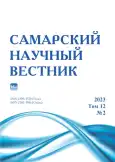Эколого-эволюционные аспекты гнездовой жизни озёрной чайки (Larus ridibundus) как колониально гнездящегося вида
- Авторы: Ламехов Ю.Г.1
-
Учреждения:
- Южно-Уральский государственный гуманитарно-педагогический университет
- Выпуск: Том 12, № 2 (2023)
- Страницы: 52-57
- Раздел: Биологические науки
- URL: https://journals.rcsi.science/2309-4370/article/view/253020
- DOI: https://doi.org/10.55355/snv2023122108
- ID: 253020
Цитировать
Полный текст
Аннотация
В данной статье анализируются эколого-эволюционные аспекты гнездовой жизни озерной чайки (Larus ridibundus), ведущей синантропный образ жизни и формирующей колонии на период размножения. Численность особей, относящихся к этому виду, начала интенсивно увеличиваться в конце XIX века, что является проявлением одного из критериев биологического прогресса. Это направление эволюции связано с повышением уровня приспособленности потомков по сравнению с предками. Прогрессивный характер развития вида затрагивает стадии годового жизненного цикла, в состав которого входят предгнездовой и гнездовой периоды. Во время предгнездового периода происходит прилет птиц в район гнездования и выбор участка для размещения колониального поселения. Сроки прилета определяются температурой, состоянием водных экосистем и физиологическими особенностями птиц. Гнездовой период включает строительство гнезда в определенной части территории, на которой строится колония. Процесс формирования колонии происходит по стадиям: одиночные гнезда в биологическом центре; микроколонии в биологическом центре; одиночные гнезда периферии колонии; микроколонии периферии. После формирования биологического центра происходит строительство гнезд на периферии. Формирование этой части колонии идет по тем же стадиям, что и биологического центра. Биологический центр занимается птицами, которые прилетают первыми на территорию колонии, и отличается от периферии ранними сроками формирования и высокой плотностью размещения гнезд. В сформировавшейся колонии, как правило, четко выделяются биологический центр и периферия. Колония как надорганизменная структура строится под влиянием экологических факторов среды, которые обеспечивают достаточный уровень приспособленности этой группировки особей к среде обитания. Полученные материалы позволят изучать моновидовые и поливидовые колонии как группировки особей, существующие на основе проявления биоценотических взаимоотношений.
Полный текст
Открыть статью на сайте журналаОб авторах
Юрий Геннадьевич Ламехов
Южно-Уральский государственный гуманитарно-педагогический университет
Автор, ответственный за переписку.
Email: dobry_bobr@mail.ru
доктор биологических наук, профессор кафедры общей биологии и физиологии
Россия, ЧелябинскСписок литературы
- Панов Е.Н. Колониальное гнездование у птиц: общий обзор // Колониальность у птиц: структура, функции, эволюция: сб. ст. / отв. ред. Д.П. Мозговой. Куйбышев: КГУ, 1983. С. 7–37.
- Михеев А.В. Пространственная структура популяций у птиц // Зоологический журнал. 1978. Т. 57, вып. 12. С. 1834–1841.
- Зубакин В.А., Рощевский Ю.К., Ходков Г.И. Об унификации терминов и основных направлениях дальнейшего изучения колониальности у птиц // Колониальность у птиц: структура, функции, эволюция: сб. ст. / отв. ред. Д.П. Мозговой. Куйбышев: КГУ, 1983. С. 4–7.
- Захаров В.Д. Птицы Южного Урала (видовой состав. распространение, численность). Екатеринбург; Миасс: ИГЗ УрО РАН, 2006. 228 с.
- Рябицев В.К. Птицы Урала, Приуралья, Западной Сибири: справочник-определитель. Екатеринбург: Изд-во Урал. гос. ун-та, 2001. 608 с.
- Виксне Я.А. Озерная чайка – Larus ridibundus Linnaeus, 1766 // Птицы СССР. Чайковые / отв. ред. В.Д. Ильичев, В.А. Зубакин. М.: Наука, 1988. С. 85–98.
- Берман З.И., Завадский К.М., Зеликман А.Л., Парамонов А.А., Полянский Ю.И. Современные проблемы эволюционной теории / под ред. В.И. Полянского, Ю.И. Полянского. Л.: Наука. Ленингр. отд-ние, 1967. 489 с.
- Лисеев И.К. Новые методологические ориентации в современной философии биологии // Методология биологии: Новые идеи (синергетика, семиотика, коэволюция). М.: Эдиториал УРСС, 2001. С. 21–32.
- Coulson J.С., White E. The effect of age and density of breeding birds on the time of breeding of the kittiwake Rissa tridactyla // Ibis. 1960. № 4. P. 71–87.
- Patterson I.J. Timing and spacing of broods in the black-headed gull Larus ridibundus // The Ibis. 1965. Vol. 107, № 4. P. 433–459.
- Харитонов В.А. Структура колонии и динамика переселения озерных чаек (Larus ridibundus) в сезон размножения // Зоологический журнал. 1983. Т. 62, вып. 7. С. 1068–1076.
- Эйнштейн А. Работы по теории относительности. СПб.: Амфора, 2008. 330 с.
- Болотников А.М., Шураков А.И., Каменский Ю.Н., Добринский Л.Н. Экология раннего онтогенеза птиц / под ред. Н.Н. Данилова. Свердловск: УНЦ АН СССР, 1985. 228 с.
- Белопольский Л.О. Экология морских колониальных птиц Баренцева моря. М.; Л.: Изд-во Акад. наук СССР, 1957. 460 с.
- Манторова Г.Ф., Вражнов А.В. Ресурсы сельского хозяйства Челябинской области в начале нового тысячелетия: справ. пособие. Челябинск: ЧГПУ, 2003. 248 с.
- Матвеев А.С., Бакунин В.А. Промысловые звери и птицы Челябинской области. Челябинск, 1994. 384 с.
- Шкляров Л.П., Никифоров М.Е. Антропогенное воздействие на численность и биотопическое размещение озерной чайки в Центральной Белоруссии (на примере Заславского водохранилища) // Распространение и численность озерной чайки / отв. ред. В.Е. Флинт. М.: Наука, 1981. С. 31–35.
- Головатин М.Г. К вопросу о пространственной структуре населения птиц // Актуальные проблемы изучения и охраны птиц Восточной Европы и Северной Азии: сб. трудов XI орнитол. конф. / отв. ред. Е.Н. Курочкин, И.И. Рахимов. Казань, 2001. С. 181.
- Харитонов С.П. Некоторые пути адаптации озерных чаек к антропогенному ландшафту // Фауна Нечерноземья, ее охрана, воспроизведение и использование / отв. ред. К.Е. Томашевский. Калинин: КГУ, 1980. С. 134–141.
- Харитонов С.П. Взаимоотношения озерных чаек (Larus ridibundus) в локальной группировке в пределах колонии // Зоологический журнал. 1981. Т. 60, вып. 6. С. 871–878.
- Ирисова Н.Л. Воробьиные птицы высокогорий Алтая на пределе вертикального распределения: автореф. дис. … канд. биол. наук: 03.00.08. Новосибирск, 1990, 26 с.
- Беклемишев В.Н. О классификации биоценологических (симфизиологических) связей // Бюллетень Московского общества испытателей природы. Новая серия. Отдел биологический. 1951. Т. 56, вып. 5. С. 3–30.
Дополнительные файлы






